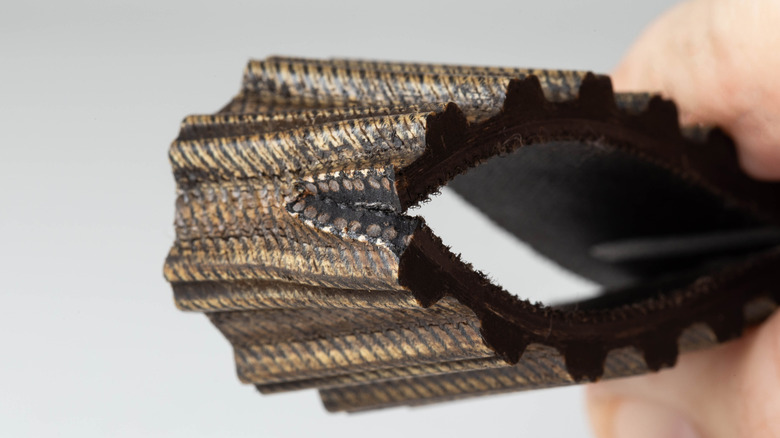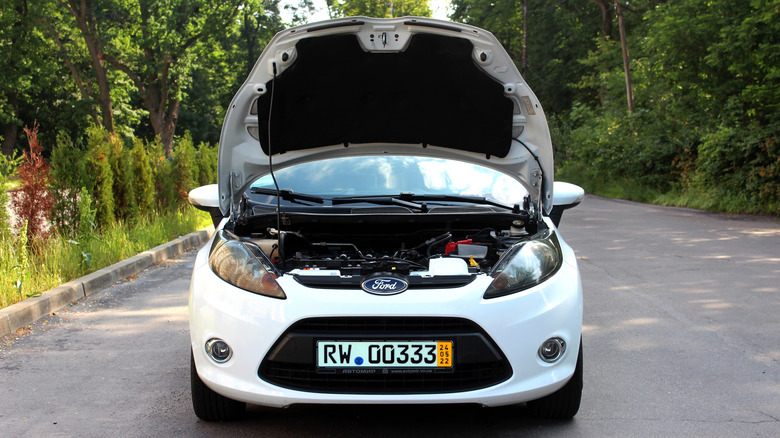Why Do Some EcoBoost Engines Use A Wet Belt? (And Why Are They Controversial?)
Ford is one of America's oldest automakers, and also one of the most influential of all time, being accredited with making a success of mass-producing cars on a moving assembly line — a feat which genuinely changed the way an entire industry moved forward. While Ford has made some remarkable decisions, such as taking Ferrari on and dominating 1960s Le Mans, Ford has also made some pretty controversial moves.
One such move was to begin producing engines which operate using a wet belt, and to cram them under the hoods of as many models as possible. Simply put, a wet belt is a timing belt that operates within the engine itself and is lubricated by the engine oil. This is unusual, as most cars with timing belts have them on the outside of the actual engine, and therefore they operate as dry belts. There are a plethora of reasons why Ford may have done this, such as to promote compact engine design, or for reduced friction on the belt itself. Whatever the reasons may be, the American automaker has upset more than just a few by implementing the design en masse. This is because Ford's wet belt system has been known to fail spectacularly, and cost a pretty penny to repair.
Customers have been left out of pocket due to wet belt failures
Unfortunately, what many owners have found out is the wet belt system within their Fords is perhaps not quite as robust as the automaker initially thought. When released, Ford claimed the belt would be good for 150,000 miles or 10 years before needing a change, but corrected themselves further down the line, instead suggesting the 100,000-mile or 6-year point as the recommended change interval. However, an investigation led by the BBC revealed that numerous customers were experiencing wet belt failure as early as 50,000 miles, on cars barely a few years old. Repair bills in these instances were in the region of £3,000 — or just north of $4,000 — and Ford wouldn't necessarily chip in to help, either. It's Ford's smaller engines which tend to operate on a wet belt system, and failure of the belt is one of the most common problems with Ford's 1.0L EcoBoost engine.
The problem these owners were finding was that the wet belt would literally disintegrate within the engine, meaning the engine would stall, and owners would be left with no choice but to fork out for a hefty repair or engine replacement. In response, Ford USA issued a recall to almost 140,000 vehicles to modify the oil pump tensioner and drive belt, improving the wet belt system's reliability.
Mechanics don't like wet belts, and here's why
Whether your car sports a wet or dry timing belt, or even a timing chain, it's bad news once they go. Valves begin crashing into pistons, and your hand starts diving into your wallet. However, things are especially bad for wet belt owners, as the belt doesn't even need to fail for your day to be ruined. If the belt merely starts to degrade slightly — which is entirely possible, as rubber belts don't particularly like hot oil baths – these small pieces of rubber debris are then immediately flung into your engine's internals. If this debris blocks your oil pickup line, and starves your engine of oil, it's new engine time, even though the belt itself is still doing its job.
It's not all doom and gloom, though. If you drive, or want to drive, a Ford with a wet belt engine, there really is no need to go hiding in fear. The best port of call is preventative maintenance, by inspecting and changing the belt regularly. You can tell if your timing belt is bad or not by inspecting it, and this is easily done with Ford's wet belt system by using a special tool through the oil cap. Changing it more often is an additional cost to consider, but it'll certainly be cheaper than forking out $4,000 or-so for a new engine every few years.


